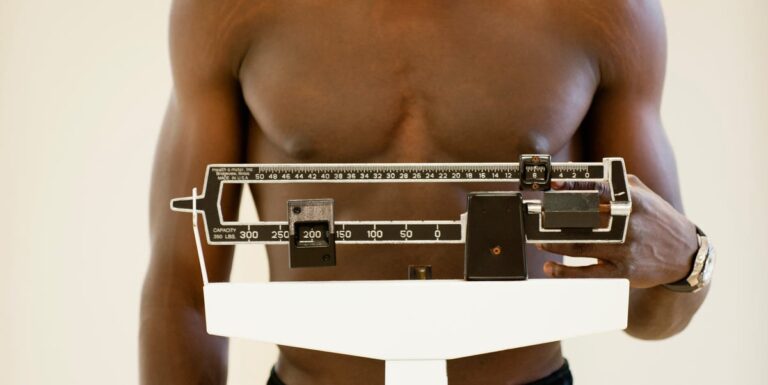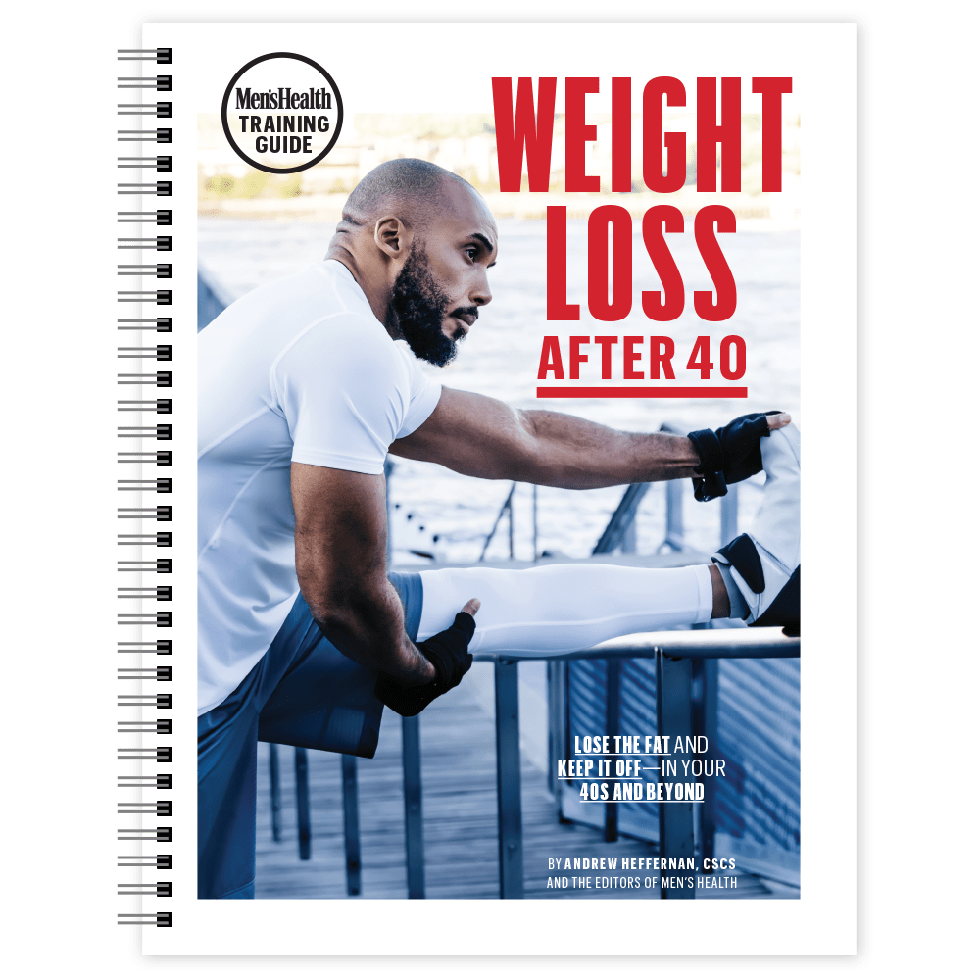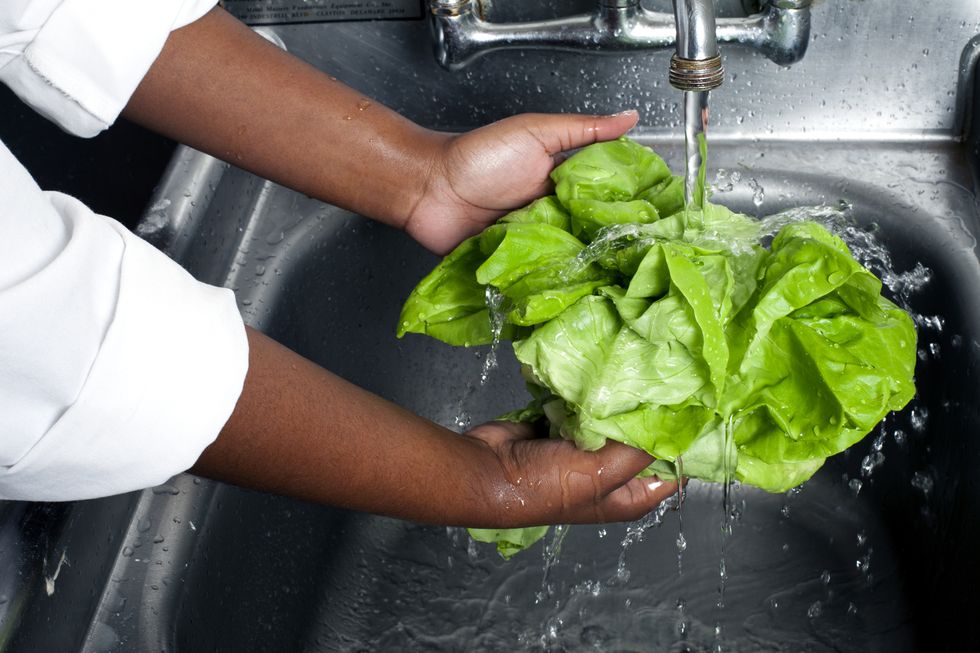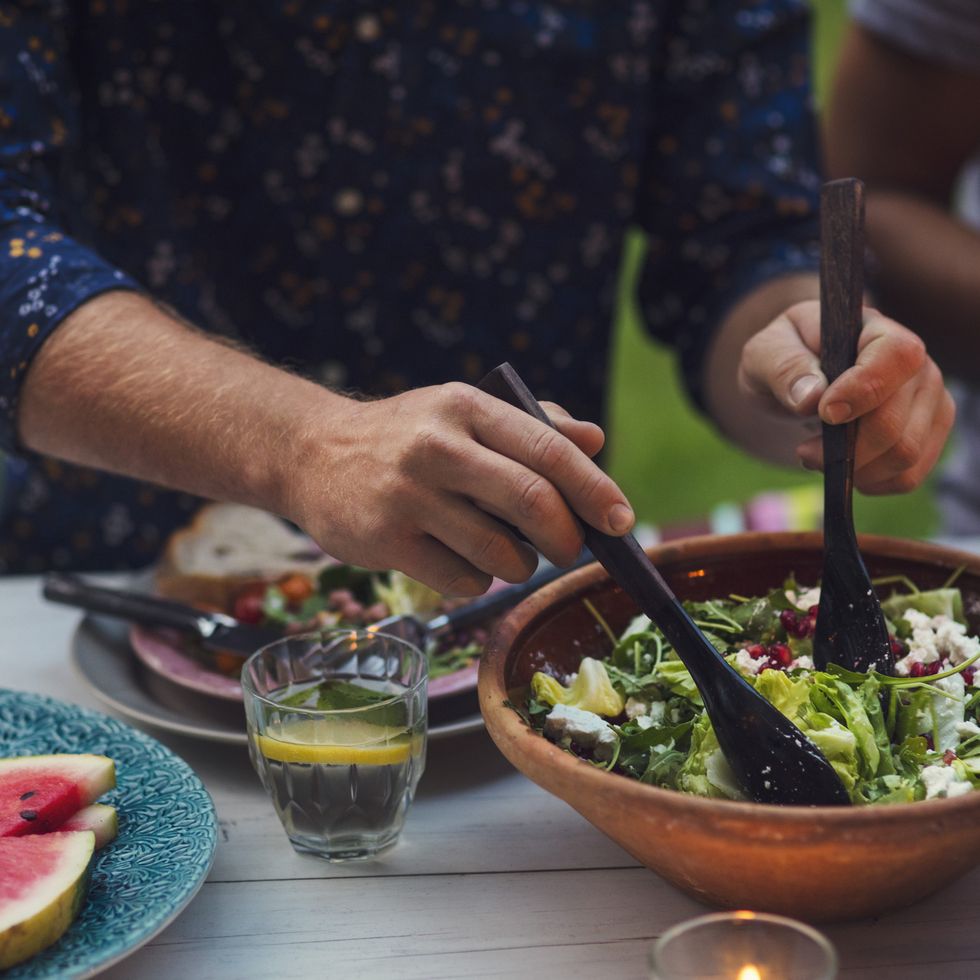[ad_1]
FEAR WEIGHT LOSS no longer. The science is in, and it doesn’t take a crash diet, a juice cleanse, or anything else dramatic in order to lose weight.
It’s all about small changes in daily habit. Yes, the healthy, science-backed solutions are way more simple than diet culture seems to lead on.
We’ve all heard about the guy how transformed himself just by calling it quits on the cola. It always sounds too good to be true, but as long as daily changes are done consistently, they can cause big-time change.
Think about it: If you’re a soda fanatic, you probably drink at least two of them a day. We can round one soda to about 240 calories. Now, what if you were to cut out just the pop from your diet, and replace it with water or a low-cal flavored seltzer?
If you punch the numbers, that’s nearly 3,360 calories that you’re cutting out of your diet weekly. Given one pound of fat equates out to 3,500 calories, you’re already almost at a loss rate of one pound per week even without changing anything else.
Even if you’re not a soda person, there’s loads of daily changes you can make to losing weight and make maintaining that weight easier. In fact, Andy Yurechko, M.S., R.D., of Augusta University Medical Center in Georgia, believes the most successful dieters avoid fads and focus on long-term sustainable practices.
“A healthier type of diet is something you can do every day of your life,” he says. So it helps to make it easy to do.
That’s exactly what these small changes are—healthy tweaks you can make to your everyday routine that have the bonus of helping you lose weight and get rid of your belly.
Overachievers, take note: The point isn’t to do everything on this list at once. Start anywhere, and add the next small step when you’re ready.
1. Set a clear goal.
A clear goal is a goal anyone in the world can measure and understand. Write out your goal and keep it posted somewhere as a reminder when you want to give up. If you have a set amount of weight you’d like to lose, step on the scale before you start. Then, weigh yourself every single day.
Studies show daily weigh-ins enhance weight loss efforts. But don’t live and die by the number. And remember a scale doesn’t decipher between fat and lean body mass—but it can help keep things in check.
2. Drink the right fluids.
First, everyone should drink plenty of water—your body needs it to run properly. And there’s a bonus in doing that for people who are aiming to lose weight. Water helps suppress our appetite, boost our metabolism, give us energy, and make exercise easier and more efficient. It really is nature’s miracle drug.
“On top of experiencing a drop in workout performance, especially in hot environments, small degrees of dehydration caused by being a light water drinker can have a negative impact on kidney function and aspects of cognition, including mood,” Stavros Kavouras, Ph.D., director of a Hydration Science Lab at Arizona State University, told MH.
If plain water just doesn’t appeal to you, try adding fresh fruit to it, or sip on tea. Research indicates that drinking tea—black, green, or white—is also associated with lower BMIs and less body fat.
3. Ease up on the processed food.
If you’re looking at the label on a food item, and you don’t know what half the ingredients are, it probably means it’s overly processed. Processed foods do nothing for you outside of creating a favorable environment for gaining fat, including visceral fat, which is the scary kind that sits on your organs.
“Too much sugar, bad fats, salt, and artificial ingredients are often found in these foods,” Leah Silberman, R.D., a registered dietitian with Medical Offices of Manhattan told MH. “Nutrient shortages and other health issues, including obesity, heart disease, and diabetes, may result from a diet consisting mostly of these items.”
If you have trouble managing particular treats—maybe it’s chips, maybe it’s cookies, maybe it’s Poptarts (because, same)—keep them out of your home or office cabinets. It’s not about willpower; it’s about being realistic. Instead, buy healthy snacks—like jerky or trail mix—for your glove compartment or desk drawer so you’re prepared at all times.
4. Eat more produce.
Fruits and vegetables fill you up, provide plenty of fiber and have few calories. If you have trouble adding vegetables to your routine, start every meal with a salad. Salad provides bulk to help fill you up so that you eat less calories overall. Or try this hack to get a day’s worth of healthy greens in 14 minutes. No smoothie required.
Although some people fear fructose, fruit will not make you gain weight, and that includes the so-called “high sugar” fruits like bananas and melons.
5. Lift weights.
Develop an exercise plan that includes heavy weights. Maintaining muscle mass takes more energy to do than maintaining fat, so our bodies burn more calories at rest. Plus, “the byproduct of [building muscle] would be trigger[ing] some fat loss,” Kurt Ellis, N.S.C.A., of Beyond Numbers Performance, told MH. “It’s going to enable you to build habits that are going to be a lot more favorable for you long term.”
In short, build more muscle, burn more calories. Make sure to cut down on rest time between sets. This keeps your heart rate elevated, causing an increase in calories burned. Use these tips to lift heavy the smart way, then try following a training plan that balances work and rest days, targets a range of muscles, and dials up the intensity as you get stronger. We’ve got a whole library of them ready for you—just use our Workout Finder below to find your perfect match.
6. Do intervals.
Study after study continues to show intervals are more effective and time efficient than longer activity performed at a lower intensity. Why not crush more calories while getting out of the gym quicker?
If you’re ready to jump right in, try this 5-minute burner on for size.
7. Do full-body exercises.
Your exercise plan—whether you’re aiming to lose weight or not—shouldn’t just focus on one area of your body. Instead, incorporate exercises that use your whole body. Think: squats, deadlifts, and chin-ups.
With full-body exercises, you’re engaging more muscle groups, making your body work harder, and burn more calories, and are “going to give you better bang for your buck,” Eric Sung, C.S.C.S, told MH. Start here, no equipment needed!
8. Track your food.
There’s no better way to find out what you’re putting in your mouth then by writing it all down. Tracking foods will help you realize how much you’re actually taking in a day. It puts things into perspective.
Use a free app, like MyFitnessPal, which makes it easy to log from anywhere. Chances are you’re eating more than you think.
9. Eat breakfast.
A study review published in the American Journal of Clinical Nutrition showed that those who ate breakfast were more successful with long-term weight maintenance. Other research has shown the same for weight loss.
Grab Greek yogurt, a piece of fruit and handful of nuts, make a smoothie, down some hard-boiled eggs or scramble them. It doesn’t have to be fancy. (But may we point out the absolute best way to make scrambled eggs? It’s also the easiest.)
10. In fact, eat the bulk of your meals in the A.M.
Then eat progressively less throughout the day. A study published in the journal Nutrients showed that eating most of your calories earlier in the day positively influences weight changes.
As the study quotes philosopher Mairmonides: “Eat like a king in the morning, a prince at noon, and a peasant at dinner.”
11. Stay active.
This means not sitting in front of a computer, TV, or phone all day. Stand and you’ll burn more and be more productive. Find high table to put your laptop on so you can stand while working. Take the stairs instead of the elevator. Park in the back of the parking lot at the grocery store. Take a walk during lunch.
Small movement changes add up big time. Research has found that just increasing your step count daily, without other added exercise, has aided in weight loss. This won’t make or break success, but every little bit helps when it comes to physical activity. A good rule of thumb: standing is better than sitting, and walking is better than standing.
12. Don’t grocery shop hungry.
If you do, you’ll opt for the bad stuff instead of sticking to your list. In fact, you’ll buy “more calories, not more food” according to a JAMA Internal Medicine study. Even short term fasting can cause bad decisions at the story.
Plan your shopping around a meal. Have dinner, and then hit the store later. Less crowds that way anyway! Or, if you’re willing to add the extra price, order your groceries online. That way you have to consciously click what you want instead of just reaching for it.
13. Replace side dishes with steamed vegetables.
It doesn’t take a rocket scientist to understand why adding vegetables to your diet will help you not only lose weight, but it will provide your body with tons of nutrients. It’s easy to make side dish swaps for veggies when you’re at home, but it’s tougher when you’re out and about.
The good news is restaurants will often allow you to substitute the fries or chips with steamed veggies. Usually without an up charge too. All you have to do is ask. Nicely.
14. Bake, don’t fry.
You’ll save calories and lower your risk of heart disease. When we fry things, we’re dipping our foods in tremendous amounts of oil that latch onto whatever we’re making, adding not just calories, but unhealthy fats to it. Baking just uses heat, and adding oil is a choice, not a necessity, to the cooking process. Or try an air fryer—you can even make just about anything in it.
You can also use the fat-burner in your backyard: the grill, which offers plenty of flavor without the need for frying. (Find the best grill gear here.)
15. Laugh!
No, really. A study in the International Journal of Obesity found those who laughed hard for approximately 10 to 15 minutes each day burned an additional 10 to 40 calories a day. On top of that, laughing has so many other mental health benefits.
So, ward off the extra pounds and depression by putting on your favorite comedy flick tonight.
16. Bump down your portions.
If you’re feeling like a change in diet isn’t for you, maybe a change in portion size is. It’s possible to lose weight just by changing how much you eat, but not changing what you eat.
This means opting for an entree instead of an entree and an appetizer. Avoid buffets and try to leave something on your plate at the end of the meal. Consider splitting a meal with your dinner companion, or skip dessert. There are so many ways to cut down how much you eat, without having to cut out some of your favorite foods.
17. Don’t socialize around the food at parties or picnics.
Social influence can be both good and bad for your weight loss journey. When it comes to going to social events, the temptation is high. You’re more likely to munch mindlessly, even though you may not be hungry. So take a step away, and hang out on the other side of the room.
Or, if you’re really feeling dedicated, try to eat BEFORE you head to the event. You’re more likely to choice a healthy meal at home, and you’ll avoid making bad snacking decisions at the event if you’re already full.
18. Take on the weight loss journey with a friend.
Like we said— social influence can be good too. If you commit to losing a few pounds with a friend, you’re more likely to keep going. Accountability is key with lifestyle changes.
Try to convince a spouse to do it with you. If you grocery shop together, and eat a fair amount of meals together, you’ll have a partner in crime to make only good decisions.
19. If you have a dog, take him for a daily walk.
Steps, steps, steps. It’s all about adding to your step count to help those activity metrics. A daily doggo walk is better for both him and you than just letting him out the back. Plus, he’ll love you even more.
If you don’t have a pet, offer to walk a neighbor’s dog (or take this as your excuse to rescue one. You’re welcome.).
20. Decrease your food intake by 100 calories per day.
Theoretically this translates to losing nearly 1 pound per month (1 lb = 3500 calories)—with hardly any effort. And, when you think about how 100 calories is only about 14 almonds or one apple, it makes the amount more fathomable. Pro tip: using smaller plates and bowls is scientifically proven to help you eat less, since it makes less food seems like more. Plus, “one must be careful that they do not reduce their caloric intake too much so that they do not lose muscle mass,” Dana Ellis Hunnes Ph.D., M.P.H., R.D., a senior clinical dietitian at UCLA medical center, told MH. Decreasing by only 100 calories does just that.
Similarly, eating slower can cut out extra calories since it takes approximately 15 to 20 minutes for your stomach to sense it’s full.
21. When possible, walk or bike to do your errands.
Have we mentioned the benefits of getting your steps in yet? Yes? Well, here’s another reminder.
If you’re lucky enough to live close to your pharmacy, grocery store, or hardware store, take advantage and walk or bike. You’ll get fresh air, burn a few calories and get your heart rate up. Buy a pedometer, or track it on your smart watch, and aim for at least 10,000 steps each day.
22. Plan ahead.
A majority of these tips will require a plan. Plan ahead to eat before you go out to a party. Plan ahead to have a meal before you hit the grocery store. Plan ahead to meal prep food that’s baked instead of friend. It all comes back to setting yourself up for success in weight loss, and weight maintenance.
If you fail to plan, you plan to fail.
23. Take “before” pictures.
If you’re looking for some weight loss inspiration, look no further. These transformation photos will have you jumping into the gym before you know it.
Taking photos can be a great way to inspire yourself along your journey. Some days can be discouraging, and it’s helpful too look back on how far you’ve come. You’ll be amazed at the progress you’ve made when you revisit the photos later.
24. Find active friends.
Your pizza, wings, beer and football-on-the-couch-all-day friends are fun for somethings, but not everything.
Research has suggested that friends can enhance (or hurt) success. Join a running club or try out a group fitness class to make some active friends.
25. Put yourself first.
It’s not selfish to want to make yourself better. Though it may feel uncomfortable to choose yourself over family or friends, it’s important to make sure you’re the best you can be to be able to care for others.
Prioritize self care to keep yourself in a good headspace, and be selfish with your time. Your friends and family will understand if you skip out on a few things to hit the gym.
26. Eat more fiber.
Fiber fills you up and helps you stay full, and it keepseverything moving smoothly when it comes to digestion. According to the Mayo Clinic, men should aim for 30 to 38 grams of fiber per day.
Avocados, lentils, oatmeal, raspberries, peas, and whole-wheat spaghetti are all great sources of fiber. If you struggle to get enough in, your doctor may recommend a supplement.
27. Drink more seltzer.
The sugar presentations in middle school health class on soda are, unfortunately, very real. And, you’ve already read about the calorie arithmetic regarding soda from above. But if you’re stuck on the pop, you might need something more flavorful than water to kick the habit.
Seltzers have come a long way since club soda, that’s for sure. Find a no- or ultra-low-calorie seltzer (the kind flavored with real fruit juice) and enjoy. The carbonation in seltzer may even trick your stomach into feeling fuller.
28. Get enough sleep.
At least 8 hours, in fact. A recent University of Chicago study found that those who were able to increase their sleep duration consumed around 260 calories per day less than those who did not reach 8 hours.
That’s nearly 2,000 calories a week. Sleep has a million other benefits, so why not sleep the weight away?
29. And stick to a bedtime.
Research shows that the later you stay up at night, the more likely you are to consume more calories throughout the course of the day. You can’t have a midnight snack if you’re going to bed at 10 pm!
And, since getting more sleep also helps you lose weight, you’re hitting two birds with one stone here. Sleep your way to better health.
30. Book a therapy session.
There’s no point in having a healthy body without having a healthy mind. The brain-belly connection is powerful— not only can having mental health issues contribute to unhealthy behaviors that can lead to weight gain, but the reverse is also true. Excess weight has been shown to have a negative mental effect on the brain. It’s a vicious spiral that can difficult to climb out of.
Men don’t seek therapy for many reasons—and most of them are total BS. There’s no shame in getting help, especially when it can help you reach your health goals.
31. Give yourself permission to indulge.
We know dieting sucks. Anything that keeps you away from your favorite foods forever is bound to be a miserable experience. But the point of eating healthy is adherence— the longer you stick with eating healthy foods, the longer you rep its benefits.
“Adherence is the most important thing for any diet to be successful, and we know people don’t stick with these restrictive diets,” says Brad Schoenfeld, Ph.D., director of the Human Performance Lab at CUNY Lehman College in New York told Men’s Health.
Steer clear of any diet that tells you NOT to eat something. A long-term healthy approach to eating makes room for pizza and cookies—but incorporates them into the bigger picture. If your diet is 80 percent good stuff, why not partake in the 20 percent—and enjoy it?
32. Eat more 30/10 meals.
Research as found that one of the easiest way to lose weight and improve your overall health is to get enough protein and fiber at each meal to properly fill you up. A new eating style was adapted out of this, where you eat at least 30 grams of protein and 10 grams of fiber at each meal. Thirty grams promote muscle maintenance and growth. Ten grams fill you up during mealtime and help you stay full until your next meal.
For 30 of these meals, just click here.
33. Fear not hunger.
Hunger is a signal that your body needs energy, not a sign of weakness. Don’t ignore it.
Studies show that fasting for too long is a gateway to binge eating. So, listen to your body. When you feel hungry between meal, opt for a snack with protein and fiber, such as an apple with peanut butter or a cheese stick and a few prunes.
34. Only eat until you’re 80 percent full.
A Japanese health practice called Hara Hachi Bu means eating until you’re 80% percent full. The region of Okinawa, where Hara Hachi Bu originated and practiced, have some of the lowest rates of heart disease, cancer, and stroke in the world, according to the Cleveland Clinic.
Your brain takes 15 to 20 minutes to process how full the stomach is. So, when you eat until you feel 80 percent full, you might actually be 100 percent full and just not feel it yet. It might be difficult to identify what 80 percent feels like, so aim to “eat until you’re not hungry, not until you’re full,” Kristin Kirkpatrick, R.D.N., consultant for integrative and lifestyle medicine for the Cleveland Clinic, told Men’s Health.
35. Find something to train for.
Whether it’s climbing Everest, or just running a 5k— find something you to sign up for, and sign up. Having a set goal with a set date will help you keep your training in check.
Finding a race that intrigues you is pretty easy. Tons of communities host all kinds of events from triathlons to mountain biking to nature walks. If you’re not quite ready for an ultramarathon yet, don’t worry. You can find 5Ks just about everywhere, and the Mayo Clinic has a free training guide.
36. Chug a class of water before every meal.
Research shows drinking water before a meal will make you feel fuller, and help you stay fuller longer. In a study done at Virginia Tech, participants who drank a glass of water 30 minutes before a meal ate 13 percent less than those who dug straight in. Another reason to keep staying hydrated!
37. Pick one goal at a time.
If we overwhelm ourselves with too many things to focus on at once, we’re likely to forget something and get discouraged on the journey of our weight loss.
“Think about having a ladder with your goals, and you’re only allowed to take one step at a time. You can only work on one thing at a time because, you know, we’re human and there’s only so much we can do,” says David Conroy, Ph.D., professor and researcher on the psychology of motivation at Penn State University told Men’s Health.
We’ve given you a long list of things to choice from here. Don’t try to do them all at the same time! Try one for the next month to get into the new habit before moving onto another. Be ambitious, but don’t bite off more then you can chew.
38. Limit calorie-heavy drinks
Sorry, folks—your pre-bed glass of wine isn’t doing much for you. Alcohol has the potential to hurt your body in a number of ways, and adds extra calories to your diet.
Same is true with calorie-heavy sodas—not only do these drinks house high levels of sugar, they’re also super high in calorie. Indulging every once in a while is okay, but limit your intake as much as possible to save up your calories for foods that will serve you.
39. Cut the sugary snacks
It’s easy to reach for cookies or granola bars when looking for something quick between meals. Snacks high in sugar might be doing us more harm than we think, though, says Jeffrey Crespin, M.D., obesity specialist based in NYC. These snacks “spike blood sugar, causing high insulin which converts sugar to fat.”
Good news—healthy snacks are pretty easy to come by and can still be satisfying.
40. Remember: It’s not all or nothing.
If you fall off the bandwagon, jump right back on. Don’t let yourself continue to fall until all weight loss progress has been lost.
Dr. Crespin graduated cum laude from Harvard University with a bachelor’s degree in biology. While at Harvard, he did research in the endocrinology lab at the Massachusetts General Hospital. After spending a year studying cinema, psychology, and literature at the Sorbonne in France, Dr. Crespin attended Washington University School of Medicine in St. Louis, Missouri, where he graduated with his medical degree. He also conducted research in Dr. Paul Lacy’s islet transplantation lab at Washington University. Dr. Crespin then completed his internship and residency training through the University of Minnesota before rounding out his training with a fellowship in Gastroenterology and Nutrition at Northwestern Memorial Hospital in Chicago, Illinois. In addition to his medical education and training, Dr. Crespin has a Master of Business Administration from the New York University (NYU) Stern School of Business.
Before opening up his private practice, Dr. Crespin served as the director of the Columbia-St. Luke’s Roosevelt GI and Bariatric clinic. Besides performing bariatric endoscopy, Dr. Crespin runs a very busy gastroenterology and weight loss practice.
Recognized as one of New York’s “Top Doctors,” Dr. Crespin is affiliated with NYU Lenox Hill Hospital, and Mt. Sinai hospitals. He is also a clinical assistant professor of medicine at NYU.
[ad_2]
This article was originally published by a www.menshealth.com . Read the Original article here. .










